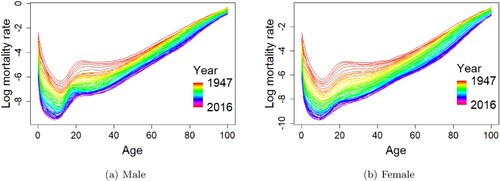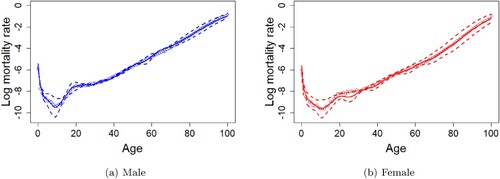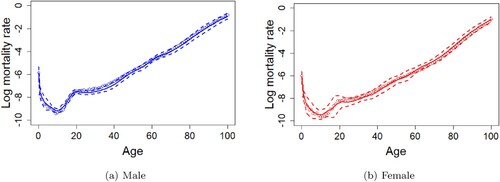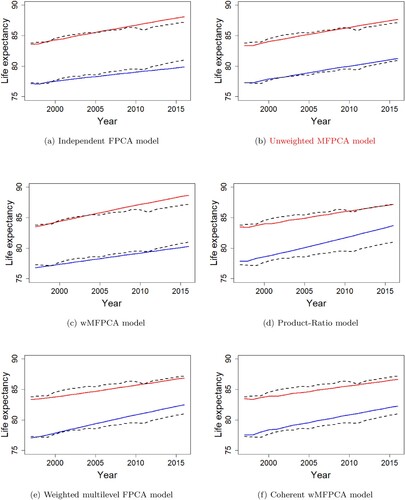Figures & data
Figure 1. Smoothed log mortality rates for males and females from the year 1947 to the year 2016 in Japan, viewed as functional data curves with time-ordering indicated by the colours of the rainbow from red to violet. (a) Male (b) Female.

Figure 2. Predicted mortality curves of male (with RMSE = 0.2006) and for female (with RMSE = 0.2406) from age 0 to age 100 with the 95% prediction intervals using the wMFPCA model for the year 2016 based on the observations from the year 1947 to the year 1996 in Japan. Circles are the true log mortality rates, solid lines are the predictions, and dashed lines are the 95% prediction intervals. (a) Male (b) Female.

Figure 3. Predicted mortality curves of male (with RMSE = 0.1821) and female (with RMSE = 0.1460) from age 0 to age 100 with the 95% prediction intervals using the coherent wMFPCA model for the year 2016 based on the observations from the year 1947 to the year 1996 in Japan. Circles are the true log mortality rates, solid lines are the predictions, and dashed lines are the 95% prediction intervals. (a) Male (b) Female.

Figure 4. 20-year life expectancy predicted curves for male and female in Japan using the independent FPCA model, the unweighted MFPCA model, the wMFPCA model, the Product-Ratio model, the weighted multilevel FPCA model and the coherent wMFPCA model. Blue sold line is used for male and red sold line is used for female. Dotted lines are the observed life expectancy for males and females. (a) Independent FPCA model, (b) Unweighted MFPCA model, (c) wMFPCA model, (d) Product-Ratio model, (e) Weighted multilevel FPCA model, (f) Coherent wMFPCA model.

Table 1. Forecast accuracy of mortality for male and female using the independent FPCA model, the unweighted MFPCA model, the wMFPCA model, the Product-Ratio model, the weighted multilevel FPCA model, and the coherent wMPFCA model is measured by the average RMSEs of ten sets of rolling windows analysis.
